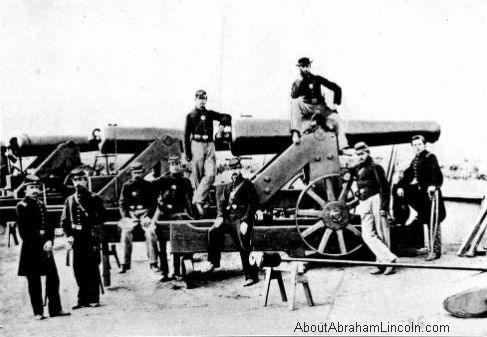The Civil War
This is an article about The Civil War.

The Civil War was the armed conflict of 1861-65, between the Northern and Southern sections of the United States. Sectional differences had existed from the beginning of the Union, but after the time of the Missouri Compromise of 1820 the differences were based largely upon the economic and social divergence between the North and the South caused by the existence of slavery.
Frequent tendencies to disrupt the government prevailed from time to time, but they increased materially after 1850, chiefly on account of the passage of the Fugitive Slave Law and the incidents connected with its enforcement. Other causes of dissatisfaction were the repeal of the Missouri Compromise in 1854, the Dred Scott Decision of the United States Supreme Court in 1858, the Lecompton Constitution for Kansas in 1858, and the John Brown Raid at Harper's Ferry in 1859.
However, the election of Lincoln in 1860 brought disunion to a head. Seven states seceded between Dec. 20, 1860, and Feb. 1, 1861. These were Alabama, Florida, Georgia, Louisiana, Mississippi, South Carolina, and Texas.
The Confederate States of America were organized on Feb. 4, 1861, at Montgomery, Ala., and the four states of Arkansas, North Carolina, Tennessee, and Virginia joined the Confederate States by July of the same year. Kentucky, Maryland, and Missouri were divided and were represented in both armies, while the western counties of Virginia remained loyal to the Union and later were organized, as the State of West Virginia.
It was at first expected by many citizens of both sections that there would be a peaceable separation.
Buchanan temporized and was succeeded by Lincoln, who at first could not see his course clearly, but when the Confederates fired upon Fort Sumter, in the harbor of Charleston, S. C., on April 12, 1861, it precipitated the conflict. President Lincoln immediately called for 75,000 volunteers to enforce the authority of the Union and declared a blockade on the coast of the Southern States.
The Confederate States likewise called for volunteers and issued letters of marque and reprisal. The North was rich and had a greater variety of industries than the South, where agriculture was the only large industry. However, the people of the South were better united and were pervaded with a more enthusiastic military spirit.
The first blood was shed in Baltimore on April 19th in a street attack on the Sixth Massachusetts Regiment, which was on its way to Washington. It was followed by active operations in the western part of Virginia, which each of the contending parties tried to hold. The Federals were defeated on June 10 at Big Bethel, Va., and on July 21 occurred the first Battle of Bull Run, when the Federals under Gen. McDowell were completely defeated by the Confederates under Generals Johnston and Beauregard. The effect of the Confederate success at Bull Run was to encourage the South and raise a determined spirit in the North, and to unify both sections in support of their respective policies.